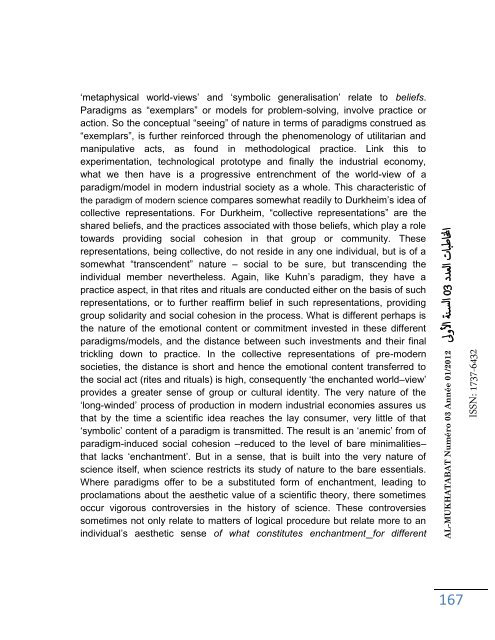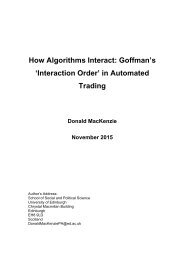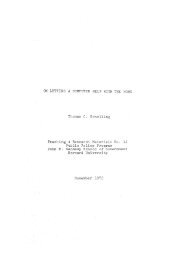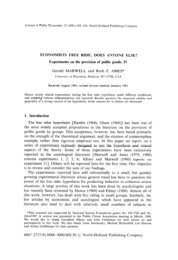n3-al-mukhatabat-journal
n3-al-mukhatabat-journal
n3-al-mukhatabat-journal
Create successful ePaper yourself
Turn your PDF publications into a flip-book with our unique Google optimized e-Paper software.
‘metaphysic<strong>al</strong> world-views’ and ‘symbolic gener<strong>al</strong>isation’ relate to beliefs.<br />
Paradigms as “exemplars” or models for problem-solving, involve practice or<br />
action. So the conceptu<strong>al</strong> “seeing” of nature in terms of paradigms construed as<br />
“exemplars”, is further reinforced through the phenomenology of utilitarian and<br />
manipulative acts, as found in methodologic<strong>al</strong> practice. Link this to<br />
experimentation, technologic<strong>al</strong> prototype and fin<strong>al</strong>ly the industri<strong>al</strong> economy,<br />
what we then have is a progressive entrenchment of the world-view of a<br />
paradigm/model in modern industri<strong>al</strong> society as a whole. This characteristic of<br />
the paradigm of modern science compares somewhat readily to Durkheim’s idea of<br />
collective representations. For Durkheim, “collective representations” are the<br />
shared beliefs, and the practices associated with those beliefs, which play a role<br />
towards providing soci<strong>al</strong> cohesion in that group or community. These<br />
representations, being collective, do not reside in any one individu<strong>al</strong>, but is of a<br />
somewhat “transcendent” nature – soci<strong>al</strong> to be sure, but transcending the<br />
individu<strong>al</strong> member nevertheless. Again, like Kuhn’s paradigm, they have a<br />
practice aspect, in that rites and ritu<strong>al</strong>s are conducted either on the basis of such<br />
representations, or to further reaffirm belief in such representations, providing<br />
group solidarity and soci<strong>al</strong> cohesion in the process. What is different perhaps is<br />
the nature of the emotion<strong>al</strong> content or commitment invested in these different<br />
paradigms/models, and the distance between such investments and their fin<strong>al</strong><br />
trickling down to practice. In the collective representations of pre-modern<br />
societies, the distance is short and hence the emotion<strong>al</strong> content transferred to<br />
the soci<strong>al</strong> act (rites and ritu<strong>al</strong>s) is high, consequently ‘the enchanted world–view’<br />
provides a greater sense of group or cultur<strong>al</strong> identity. The very nature of the<br />
‘long-winded’ process of production in modern industri<strong>al</strong> economies assures us<br />
that by the time a scientific idea reaches the lay consumer, very little of that<br />
‘symbolic’ content of a paradigm is transmitted. The result is an ‘anemic’ from of<br />
paradigm-induced soci<strong>al</strong> cohesion –reduced to the level of bare minim<strong>al</strong>ities–<br />
that lacks ‘enchantment’. But in a sense, that is built into the very nature of<br />
science itself, when science restricts its study of nature to the bare essenti<strong>al</strong>s.<br />
Where paradigms offer to be a substituted form of enchantment, leading to<br />
proclamations about the aesthetic v<strong>al</strong>ue of a scientific theory, there sometimes<br />
occur vigorous controversies in the history of science. These controversies<br />
sometimes not only relate to matters of logic<strong>al</strong> procedure but relate more to an<br />
individu<strong>al</strong>’s aesthetic sense of what constitutes enchantment for different<br />
AL-MUKHATABAT Numéro 03 Année 01/2012 لىولأا ةن سلا 30 ددعلا تابطانا<br />
167<br />
ISSN: 1737-6432







